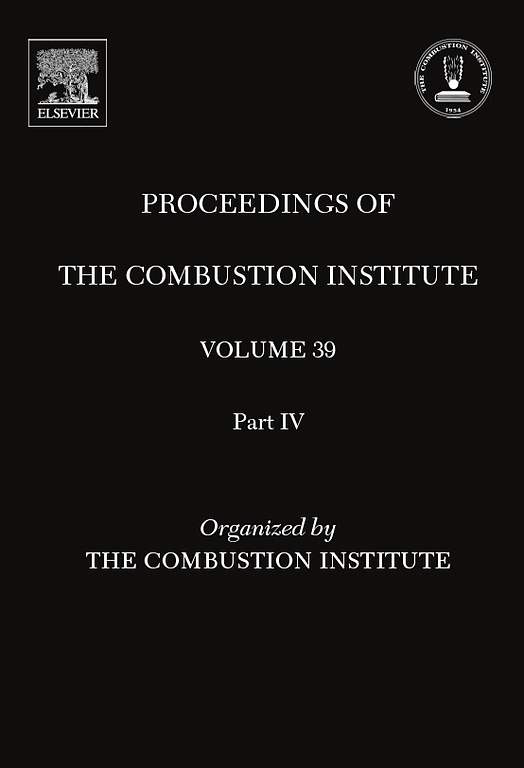Exhaust emissions point measurements on the secondary stage of an NH3-RRQL system
IF 5.2
2区 工程技术
Q2 ENERGY & FUELS
引用次数: 0
Abstract
The Rich-Relaxation-Quench-Lean (RRQL) combustion system was recently proposed to increase combustion efficiency in ammonia (NH3)-fueled gas turbines while reducing nitrogen oxides (NOx). Success requires precise control of the lean secondary stage, where air oxidizes the remaining fuel from the rich primary stage. However, understanding pollutants distribution across the secondary stage is crucial for designing RRQL systems that minimize NOx and nitrous oxide (N2O) emissions. This study experimentally investigates axial and radial distributions of exhaust species across the secondary stage of a lab-scale NH₃-fueled RRQL burner. The burner operated with rich premixed NH3–air mixtures and employed a secondary air injection geometry of five-4.1 mm diameter holes, selected for its ability to stabilize diffusion-like flames at ϕglobal = 0.85 and premixed-like flames at ϕglobal = 0.60. A fused quartz probe enabled gas sampling at multiple locations upstream within, and downstream from the secondary injection plane. At ϕprimary = 1.13, results show that NO is formed slightly upstream the air injection plane, whereas NO2 is rapidly produced downstream and NH3 and N2O slip through the walls between the jets. A notable fraction of total NOₓ was found to be NO2, post-secondary combustion zone, underscoring the need to consider NO2 explicitly in overall emissions assessments of staged NH₃ combustion systems. Decreasing ϕglobal to 0.60 reduces the overall emissions, highlighting the importance of premixed-like combustion in pollutants mitigation in the secondary stage. Although similar trends were observed at ϕprimary = 1.15, higher NOx levels resulted from increased NH₃ availability. However, thermal insulation of the combustor walls effectively reduced NH₃ slip, likely due to enhanced non-oxidative cracking, enabling sub-10 ppm N2O emissions. These findings emphasize the importance of simultaneous primary and secondary stage tuning, reduction of heat losses, and the promotion of premixed-like combustion through adequate jet momentum for optimal performance of NH3-fueled RRQL systems.
NH3-RRQL系统二级废气排放点测量
富松弛-淬灭-贫(RRQL)燃烧系统最近被提出,以提高氨(NH3)燃料燃气轮机的燃烧效率,同时减少氮氧化物(NOx)。成功需要精确控制稀薄的二级,在那里空气氧化从丰富的一级剩余的燃料。然而,了解污染物在整个二级阶段的分布对于设计RRQL系统以最大限度地减少氮氧化物和氧化亚氮(N2O)的排放至关重要。本研究通过实验研究了实验室规模的NH₃燃料RRQL燃烧器二级排气物质的轴向和径向分布。燃烧器使用丰富的预混nh3 -空气混合物,并采用5 -4.1 mm直径孔的二次空气喷射几何形状,选择该形状是因为它能够稳定扩散型火焰在ϕglobal = 0.85和预混型火焰在ϕglobal = 0.60时。熔融石英探头可以在二次注入面上游和下游的多个位置进行气体采样。在ϕprimary = 1.13时,NO在喷气面上游形成,而NO2在喷气面下游迅速生成,NH3和N2O通过射流之间的壁面滑动。总NOₓ的显著部分被发现是NO2,后二次燃烧区,强调需要在分级NH₃燃烧系统的总体排放评估中明确考虑NO2。将全球ϕ值降低至0.60可减少总排放量,突出了在二级阶段减少污染物的预混式燃烧的重要性。尽管在ϕprimary = 1.15时观察到类似的趋势,但NH₃可用性的增加导致了更高的NOx水平。然而,燃烧室壁的隔热层有效地减少了NH₃滑动,可能是由于增强的非氧化性开裂,使N2O排放低于10 ppm。这些发现强调了同时调整一级和二级的重要性,减少热损失,并通过足够的射流动量促进预混燃烧,以实现nh3燃料RRQL系统的最佳性能。
本文章由计算机程序翻译,如有差异,请以英文原文为准。
求助全文
约1分钟内获得全文
求助全文
来源期刊

Proceedings of the Combustion Institute
工程技术-工程:化工
CiteScore
7.00
自引率
0.00%
发文量
420
审稿时长
3.0 months
期刊介绍:
The Proceedings of the Combustion Institute contains forefront contributions in fundamentals and applications of combustion science. For more than 50 years, the Combustion Institute has served as the peak international society for dissemination of scientific and technical research in the combustion field. In addition to author submissions, the Proceedings of the Combustion Institute includes the Institute''s prestigious invited strategic and topical reviews that represent indispensable resources for emergent research in the field. All papers are subjected to rigorous peer review.
Research papers and invited topical reviews; Reaction Kinetics; Soot, PAH, and other large molecules; Diagnostics; Laminar Flames; Turbulent Flames; Heterogeneous Combustion; Spray and Droplet Combustion; Detonations, Explosions & Supersonic Combustion; Fire Research; Stationary Combustion Systems; IC Engine and Gas Turbine Combustion; New Technology Concepts
The electronic version of Proceedings of the Combustion Institute contains supplemental material such as reaction mechanisms, illustrating movies, and other data.
 求助内容:
求助内容: 应助结果提醒方式:
应助结果提醒方式:


